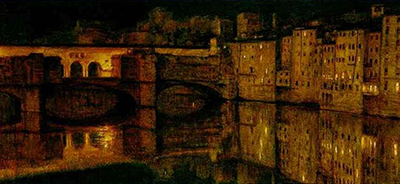A romantic style infuses the Holman Hunt's watercolour of the most famous bridge in Italy. He painted the Ponte Vecchio in 1867 in watercolour on paper, However, the backdrop of night-time darkness symbolised the tragic personal events of the previous year.
William Holman Hunt was a founding member of the pre-Raphaelite Brotherhood. After their disbandment, Holman Hunt continued to honour the ideals of the movement, painting serious subjects with great attention to detail and realism. In 1866 Holman Hunt and his wife, Fanny, who married in 1861 had been travelling back from Egypt. Fanny was pregnant and after arrival in Florence, the couple decided it would be wiser to remain in the city until the baby was born. In October 1866 Fanny gave birth to their son. Although the birth was difficult the baby survived, but a few months later in December 1866, whilst still in Florence, Fanny Holman Hunt died of a fever.
Bereft, William Holman Hunt was to return to London the following year to continue his career as an artist. Before leaving, he painted the work Ponte Vecchio, Florence. The Ponte Vecchio, which translates as 'old bridge', is a medieval stone bridge that spans the River Arno and forms a focal point of Florence. Famous for the goldsmiths and jewellers workshops that line the street over the bridge, it is not hard to imagine that this landmark held some significance for Holman Hunt and his wife.
The painting is a fitting tribute by Holman Hunt to the city where he and his wife had shared such happy and expectant times only months before the painting was made. The poignancy of the work is inescapable. The artist captures the understated beauty of the bridge at night, with glimmering yellow lights glowing from the buildings. Shimmering illuminations are reflected in the water, lifting what would otherwise be a gloomy city landscape. The scene is understated, with a limited palette, but it effectively represents both the grief of loss and the hope of a new life. This striking and unusual painting by Holman Hunt can now be found in the V&A Museum in South Kensington, London.




